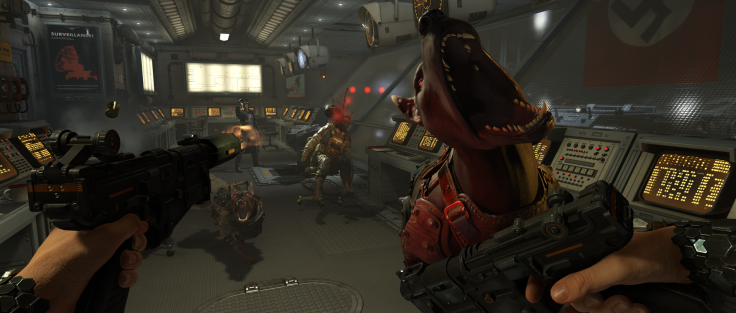Wolfenstein II: The New Colossus demonstrates a surprising limitation on the empathic capacities of video games as a storytelling medium.
Early in the game, players live through a brutal moment in BJ Blazkowicz’s childhood: after ranting about Jews and black people, Daddy Blazkowicz forces young BJ — you — to shoot your own dog with a shotgun. Whether it’s senseless brutality, or as Kotaku would have it, a savvy positioning of violence as a “lasting force” in need of disruption through more violence, it’s not a particularly soul-stirring moment. Pulling the trigger cost me nothing and left me unshook. Not because I’m jaded to violence, but because certain assumptions about video game storytelling don’t bear out in practice, requiring existing, non-gaming narrative techniques instead. A story moment from South Park: A Fractured But Whole demonstrates this need, creating a far more agonizing decision than what Wolfenstein II puts you through.
The relationship between video games and empathy is a hot topic. Where games were once presumed by the wider culture to reduce empathy, even driving kids to shoot up schools, the new consensus is the exact opposite. Video games, especially “prosocial” ones, are the “ ultimate empathy machine,” capable of resituating people inside a different perspective, very nearly literally walking in someone else’s shoes.
So why do I feel nothing shooting B.J.’s realistic-looking mutt, even with my finger situated on a realistic trigger, my perspective narrowed to B.J.’s own? South Park: The Fractured But Whole offers an answer. Unlike the “agonizing” choice in Wolfenstein II, made right at the game’s beginning, The Fractured But Whole saves its most shocking moment for very late in the game, so this will be a spoiler.
Late in The Fractured But Whole campaign, your superhero team visits the genetic-engineering labs of Dr. Mephisto. Yes, he’s still obsessed with animals with multiple asses. You find your kidnapped parents strapped down in a laboratory. The only way out is to provide a DNA sample to the computer, either by ripping off your mother’s arm, bleeding her out, or cutting of your dad’s head with a laser.
It’s a grotesque moment, but made darkly comic thanks to its over-the-top gruesomeness and your parents’ typical bickering, passively-aggressively sniping at each other and manipulating you to kill the other. And, of course, this is South Park, where characters look like construction paper cutouts, not real people.
If video games are a medium with immersion as its great strength, then BJ Blazkowicz’s far more realistic and intentionally upsetting decision should be more effective. My experience was the opposite. I was surprised by just how horrified and upset I felt performing the QTE event to slice off my father’s head with a laser.
There are three major reasons I can think of for why South Park: The Fractured But Whole’s decision is more agonizing than Wolfenstein II’s. The first is the simple familiarity established over time. In the South Park game, you come to know your mom and dad well, even if you probably don’t like them. The familiarity that accrues over time and exposure is essential to other storytelling mediums, particularly television. We come to love characters, even identifying with horrible people like Tony Soprano. Anyone who has tried putting on a favorite late-season episode of a show for an audience of first-timers has experienced this.
The second is something not often ascribed to South Park: nuanced writing. Where Daddy Blazkowicz is literally a mustache-twirling villain, complete with the railroad baron wardrobe beloved by Snidely Whiplash, your parents in The Fractured But Whole are despicable in familiar ways. They’re weak, adrift, selfish and don’t like each other much, so they abuse substances and just generally aren’t very good parents. In other words, a little like many, many real parents. By inducing pity as much as contempt in the player, the decision to kill feels less like video game justice and more like killing a real person.
Finally, there’s the nature of the decision tree and how each agonizing decision frames its stakes and outcomes. Whereas the binary presented in Wolfenstein — shoot or don’t shoot your dog — doesn’t feel like a hard choice, draining the decision of any sense of consequence, paradoxically making it easier to shoot the dog, the relatively equal outcomes of your Fractured But Whole decision is far more likely to spark uncertainty and doubt. This, again, is a quality equally applicable to TV or movie writing. Lots of shows try to do tough decisions, but when only one outcome makes sense to the viewer, it doesn’t end up feeling agonizing at all.
While promising studies have pointed to behavioral changes brought on by VR experiences, such as increased understanding of life from a color-blind person’s perspective, there remains a material gap between the experience of gaming’s natural immersiveness and emotional empathy. Tricking our senses isn’t the same as tricking our hearts.
The New Colossus shows that it doesn’t happen automatically. There are many emotions and empathetic reactions that do happen nearly automatically while playing video games, but the medium will continue to depend just as much on qualities not unique to gaming — good old-fashioned storytelling most of all.
- Great story
- Fun, if repetitive, gameplay
- Memorable characters
- Minor bugs


















![[EG April 19] Best 'Stardew Valley' Mods That Will Change](https://d.player.one/en/full/226012/eg-april-19-best-stardew-valley-mods-that-will-change.png?w=380&h=275&f=955520b8313253ee3c39c791f6210f38)
